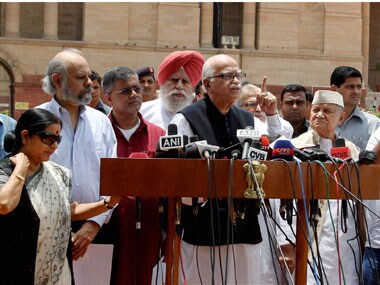Two months after Gandhian Anna Hazare’s fast over corruption and the Lokpal bill, nothing has moved much. Regular politics has come into play and there is a lot of bad blood going around. The Indian version of the Arab Spring has lost its way in the battle of egos and posturings. The promised revolutionary change is no more a question of when, but one of how. Here’s how various players stand at this point: Baba Ramdev: The yoga guru is playing the victim card perfectly at the moment. Sitting at his ashram in Haridwar, he keeps throwing challenges at the government on a daily basis. And why not? He has the civil society behind him, a section of the political class has taken up the cudgels on his behalf, and now the Supreme Court wants answers from the government on the midnight raid at the yoga guru’s camp. The limelight has followed him from ‘dangerous’ Delhi to the sylvan surroundings of home. The civil society: The trust deficit between the government and the civil society continues. The chasm has gone wider and the distrust has deepened after the Ramdev episode. The fate of the Lokpal draft bill is more uncertain now. The civil society members are talking tough, but the government is apparently not in a mood to compromise beyond a point. If the Ramlila Maidan incident is an indicator, it is not averse to taking risks. The atmosphere is too vitiated for a normal dialogue. They could have done better without Ramdev in the picture; he brought smuggled politics into the movement. The UPA: The government at the Centre has decided to be more unpopular and care a damn about it. After staying on the defensive for long, it has let the party’s big mouths loose on challengers and critics. It has turned combative, but it’s still not clear at whose orders. Both its top leaders — Prime Minister Manmohan Singh and Congress chief Sonia Gandhi — continue to be invisible. There’s no clear communication from the party on any issue. A day after the aggressive statements on the Ramdev issue, the big guns have gone mute. It is a government negotiating all the time, not running the country. [caption id=“attachment_21281” align=“alignleft” width=“380” caption=“Senior BJP leader LK Advani, flanked by other top NDA leaders, talking to the media after submitting a memorandum to President Pratibha Patil in the wake of police crackdown on Baba Ramdev and his supporters. PTI”]
 [/caption] The BJP: Main opposition, the BJP, has run out of original ideas and the drive to grow as an alternative to the Congress. It continues to ride piggyback on others to make its presence felt. The Ramdev episode is an example. The party is organising a satyagraha at Rajghat today to protest against the police raid on the yoga guru’s camp at Ramlila Maidan. It sees parallels to the Emergency of 1975 in the incident. Two days later, it would have jumped to something else. The party responds to the news cycle in the media seriously. The citizens: Taken in by the great change promised by the civil society and all other stakeholders in the recent churn over corruption, the ordinary Indian stands confused now. The scandal perpetrated by former telecom minister A Raja was shocking as were the brazen acts of corruption by the Commonwealth Games Organising Committee former chief Suresh Kalmadi. The civil society movement promised to overthrow the corrupt. Their support to it was absolute and without any reservation. They are not clear what’s happening now. Given how things stand, there’s little possibility of any movement in the anti-corruption drive. Driven to the extreme, it might lead to the collapse of the ruling government. But that does not mean much. Even Jayapraksh Narayan’s movement that led to the Emergency and the subsequent political change achieved little in terms of altering the corruption scenario. Something is wrong. The country is not mature enough to sit down and sort out its problems. A sorry state of affairs, indeed!
[/caption] The BJP: Main opposition, the BJP, has run out of original ideas and the drive to grow as an alternative to the Congress. It continues to ride piggyback on others to make its presence felt. The Ramdev episode is an example. The party is organising a satyagraha at Rajghat today to protest against the police raid on the yoga guru’s camp at Ramlila Maidan. It sees parallels to the Emergency of 1975 in the incident. Two days later, it would have jumped to something else. The party responds to the news cycle in the media seriously. The citizens: Taken in by the great change promised by the civil society and all other stakeholders in the recent churn over corruption, the ordinary Indian stands confused now. The scandal perpetrated by former telecom minister A Raja was shocking as were the brazen acts of corruption by the Commonwealth Games Organising Committee former chief Suresh Kalmadi. The civil society movement promised to overthrow the corrupt. Their support to it was absolute and without any reservation. They are not clear what’s happening now. Given how things stand, there’s little possibility of any movement in the anti-corruption drive. Driven to the extreme, it might lead to the collapse of the ruling government. But that does not mean much. Even Jayapraksh Narayan’s movement that led to the Emergency and the subsequent political change achieved little in terms of altering the corruption scenario. Something is wrong. The country is not mature enough to sit down and sort out its problems. A sorry state of affairs, indeed!
Trapped in politics, India’s Arab Spring loses direction
Akshaya Mishra
• June 6, 2011, 18:55:39 IST
No progress in anti-graft drive. Politics and avoidable distractions have crept in to weaken a promising movement.
Advertisement
)
End of Article